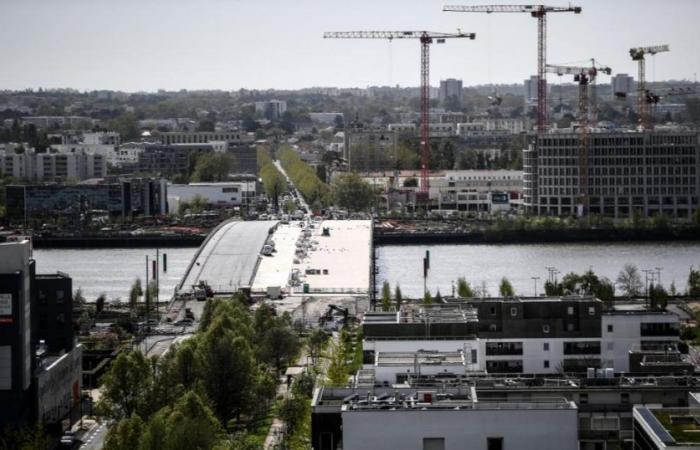
IN IMAGES, IN PICTURES – Around the future Simone-Veil bridge, which will be inaugurated at the beginning of July, the gigantic Euratlantique district aims to accommodate 50,000 inhabitants and 30,000 jobs, on approximately 738 hectares of former railway and industrial wasteland.
When a low city rises. In Bordeaux, famous for its shops and one- or two-story houses, new neighborhoods are growing vertically to accommodate the incessant flow of new residents into the metropolis, like the immense Euratlantique project.
The new districts created by this development operation will culminate in the inauguration, at the beginning of July, of the Simone-Veil bridge, which will be the eighth to span the Garonne in the Gironde conurbation. Symbolically, it will unite the three cities of this urban development project, the largest outside the Paris region: Bordeaux, Bègles and Floirac.
Bassins à flot, Ginko, Bastide-Niel, Brazza: other new districts have emerged from the ground to support the objective of a metropolis with one million inhabitants carried out in the 2000s by the former mayor of Bordeaux Alain Juppé and the former socialist president of the intercommunality Vincent Feltesse.
Christophe ARCHAMBAULT / AFP
One million inhabitants by 2038
But Euratlantique, an operation declared of national interest in 2009 to support the arrival of the Paris-Bordeaux high-speed rail line, inaugurated in 2017, is on a completely different scale. Extended from the end of 2023 until 2040, the project aims to accommodate 50,000 inhabitants and 30,000 jobs on 738 hectares of railway and industrial wasteland. Demographic pressure is strong in the metropolis, which brings together Bordeaux and 27 other municipalities: the population gains 10,000 inhabitants per year and could reach one million inhabitants in the agglomeration by 2038.
Towers are flourishing, sometimes with innovations, such as the wooden frame symbolized by Hyperion, the tallest building in France of this type, or the future Tebio, the first reversible building in France which can be used either for housing or for offices . This new landscape contrasts with the neighborhoods of small, low houses, or “stalls,” which frame the historic heart of the city, itself limited to three or four floors.
“Bordeaux is a lower town, a town of shops, for historical, geographical and geological reasons (marshy soils), with, before the 1950s, emergences made up of bell towers”explains Mayor Pierre Hurmic. “If we want more residents, to densify more, we can usefully go through raising the height of buildings, I am very in favor of it, but we will not do it just anywhere”he adds.
CHRISTOPHE ARCHAMBAULT / AFP
“A city on the trajectory of neutrality”
Some residents living near the first Euratlantique buildings which are beginning to emerge from the ground, such as the Amédée Sacré-Cœur residents’ collective, nevertheless denounce a “excessive concreting”. In the new neighborhoods, the slogan displayed is diversity, with a social housing quota of 35%, which will even be increased to 40% in future projects in Bordeaux to catch up with the city (19% instead of 25% required by the SRU law) but also regulated sales prices for vacant housing, lower than the metropolitan average.
New types of businesses, such as a hotel-youth hostel with a large bar equipped with a stage and a “rooftop” or even a hall mixing trendy bars and restaurants, are targeting a new population coming to settle in the neighborhoods close to the station, made attractive by the LGV and the rise of teleworking. The new offices still bear the mark of Euratlantique’s initial ambition, which was to create a business district, such as the imposing headquarters of the Caisse des Dépôts et Consignations.
Today, the objective displayed by Euratlantique during the time of Alain Juppé is officially buried. The new roadmap adopted last year now talks about revegetation, dewaterproofing and consultation with residents, in order to build “a city on the path to carbon neutrality”according to the general director of Euratlantique, Valérie Lasek.
Christophe ARCHAMBAULT / AFP





